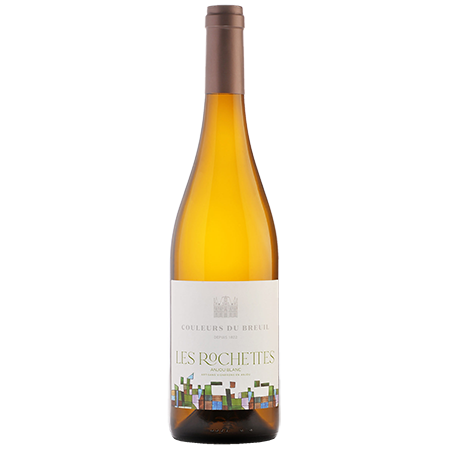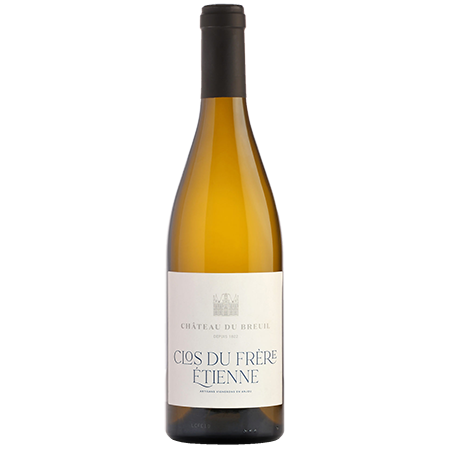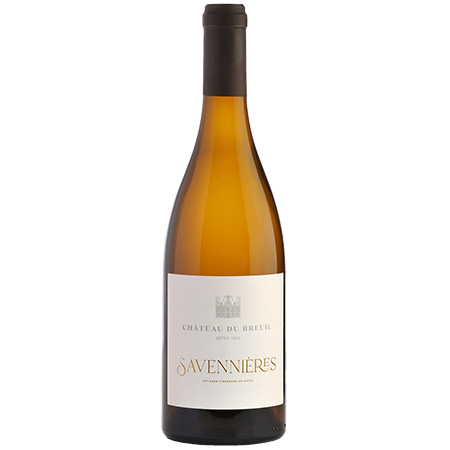Châteaux du Breuil et de la Roche
(broye eh-day-la-roesh) | Anjou – Loire Valley
In France’s majestic Loire Valley lies Châteaux du Breuil et de la Roche…
situated on the right bank of the Layon river near the village of Beaulieu-sur-Layon, 20 minutes south of Angers. Built in 1822, Le Breuil’s vines are planted on prime L’Anjou Noir plots: south-facing slopes of the Coteaux du Layon, resting on a bed of schist just above a seam of spilite that runs between the towns of Beaulieu-sur-Layon and Rochefort-sur-Loire. The winery also owns a prime vineyard across the Loire river, in the heart of Savennières. The Anjou region lies in a climatic transition between the oceanic climate of the coast and the continental climate of the upper Loire and central France. Châteaux du Breuil primarily focuses their work on producing exceptional dry chenin blanc, as well as other local grape varieties, like grolleau, cabernet franc, sauvignon blanc and gris, and chardonnay.
Anjou is famous for the supreme complexity of its geology, with a multitude of diverse volcanic rocks present; yielding some of France’s most substantial, exciting white wines, both dry and sweet, from the chenin blanc grape variety.
The modern era of Châteaux du Breuil et de la Roche began when French businessman and wine-lover Michel Petitbois bought the estate in 2006 with the intention of making great wine. Michel, a forward-thinking collector of fine wines from Burgundy, fell in love with the complexities of the Loire Valley and saw the potential in the exceptional vineyards owned by Châteaux du Breuil to produce exceptional wines. Some of their notable, direct neighbors include Château Pierre-Bise, Château Soucherie, and Château Plaisance, while just a footpath separates their Savennières vineyard from those of Nicolas Joly. The philosophy of Châteaux du Breuil et de la Roche begins with its exceptional vineyards and regenerative farming methods.
Once Michel Petitbois purchased the historic estate in 2006, he reorganized and revitalized the vineyards and modernized the cellar. From the beginning, Michel knew that if he wanted to secure Châteaux du Breuil’s future on a world-class level, there was considerable work to be done in both the vineyard and cellar. Starting with 24 hectares of vineyards from previous owners, his team pulled up 12 hectares of vines that were haphazardly planted; they reorganized and replanted the vineyards according to the correct terroir, with old clones selected for quality and complexity. Over the ensuing two decades, Michel gradually purchased key vineyards, bringing the estate to its current 33 hectares of vines. Châteaux du Breuil now produces wines in the Protected Designation of Origin regions of: Anjou, Savennières, Coteaux du Layon, Coteaux du Layon Beaulieu, Crémant de Loire, and Rosé d’Anjou.
One of the defining factors of the winery’s approach is the collaborative, team-focused leadership style of Mr. Petitbois and his decision to assemble an all-star group from local talent. Upon completion of the rehabilitation of the vineyards and cellar, Michel set out to find the right managing partner to guide the property towards greatness; he found that partner in Anjou native David Vigan, a world-class sommelier, who had been the Wine Director at Michelin star restaurants in Saumur, Paris, and Switzerland. Born in Angers, David grew up in the tiny village of Valanjou, just a few kilometers south of Châteaux du Breuil. As Managing Partner, David is easygoing and affable, with an encyclopedic, masterful understanding of not only the region and its terroir, but, of equal importance, the region’s culture, gastronomy, and history. David Vignan is at the heart of the closely-knit, diversely-talented team at Châteaux du Breuil.
The Châteaux du Breuil team also includes: Valentin Guibret, Nantes native and vineyard manager since 2018; Olivier Bouet, oenologist since 2009; Bruno and Carole, who have worked in various capacities at the property since 2006; and Sandrine Bertaud, who runs the administrative and commercial side of the winery. While each member has their specialty, they are all cross-trained in other disciplines to better understand how their work relates to the greater sum of its parts and, of course, the finished wine.
The foundation of the winery lies in their superlative regenerative, certified-organic farming methods. The team has been working without the use of herbicides, pesticides or chemical fertilizers since 2007, receiving their organic certification from Ecocert in 2015. The vineyards of Châteaux du Breuil et de la Roche are among the most vibrant we have visited, exemplified by their use of various cover crops in between vine rows. While each plot is handled individually, in general, they employ green manures from compost to the vineyard. Tillage is limited to the cavaillon and décavaillon, the mounding of earth to protect the vines in winter and spring. The Breuil team also utilizes native hedges, trees, and low stone walls as natural windbreaks and as pathways for wildlife to enter the vineyards from the forest. The resulting soil health is remarkable—turning over the soil in the Breuil vineyard reveals a rich network of mycelia (fungal organisms), earthworms, insects, and native ground cover, such as wild onion, garlic, and clover, among many others. The soils in the vineyards of Châteaux du Breuil et de la Roche are a textbook example of what can be accomplished through the practice of regenerative agriculture with living soils as the ultimate goal.
Châteaux du Breuil has a magnificent two-hectare parcel of chenin blanc on the Savennières Plateau, called ‘L’Enclos’ at 180 meters, near the neighboring vineyards of Nicolas Joly, Domaine Roche Aux Moines, and Belargus. The region’s famous schist soils are clearly evident at the surface of the vineyard. ‘L’Enclos’ routinely produces world-class wines that are the perfect combination of power, elegance, and grace, with an everlasting finish.
Another vineyard yielding top wines is ‘Clos du Frère Étienne’, a five-hectare vineyard in Anjou replanted to old, low-yielding, chenin blanc clones in 1994. Soil studies demonstrate only two to three feet of earth cover over a solid schist bedrock below the vines. Their resulting Clos du Frère Étienne Anjou Blanc produces two barrels of wine even more richly textured than Savennières, yet with a distinct mineral profile. An impressive wine with incredible clarity, intrigue, and emotion that you can drink now, or allow to improve in bottle for 10 years or more.
Across the Rue de Rochefort from the winery, facing south towards the Layon river, lies an important 1.5 hectare vineyard called ‘Clos de la Guerche’ (100-150m), planted on a vein of hard volcanic stone called spilite that runs through the region south of Beaulieu-sur-Layon, near Châteaux du Breuil et de la Roche. Spilite is very hard, stronger than schist and is often used in road construction in the region. In addition to spilite, the vineyards here contain an incredibly complex mixture of schists, sandstone, and puddingstones, lending exceptional intricacy to the wines. While the clos was replanted in 2018 and is still young, David Vigan and Michel Petitbois feel this parcel has a promising future, perhaps becoming an Anjou Blanc Cru one day. The vineyard is located within a secluded zone, on the border of the Pont-Barré Natural Reserve, a jewel of protected biodiversity enclosed by trees, shrubs, and low stone walls, where birds, butterflies, and wild tulips prosper. Châteux du Breuil’s Clos de la Guerche vineyard borders the top of the Coteau des Treilles vineyard, once owned and made famous by Jo Pithon and Jo Paillé, now owned by Domaine Belargus and vinified for their Anjou Blanc ‘Treilles.’
They also produce an Anjou Rouge from cabernet franc vines in a two hectare vineyard called ‘Le Bois de la Haie’, which is surrounded by trees and has some of the most beautiful, living soils possible in a vineyard. The resulting red is one of the finest examples from the Anjou region, with plenty of fruit expression and fine tannins, devoid of some of the harsher characteristics often found in Anjou Rouge. David Vigan attributes the success of his Anjou Rouge to the soil structure of the parcel, noting that he has seen constant improvement in the tannin structure due to the health of the soil.
The chai (winery) was rebuilt in 2007 and outfitted with stainless steel tanks and temperature control, so that each parcel could be handled and vinified separately. The philosophy in the cellar is to protect and retain the purity of the fruit with as minimal intervention as possible. They use only the coeur du cuvée, the heart of the first pressing, for their estate wines. At harvest, each vineyard is monitored carefully for the desired balance, as they are always looking for the utmost elegance. Whole bunches are sorted first in the vineyard into small crates and then brought to the winery, where they are carefully washed to avoid the introduction of Brettanomyces (a necessary step to preserve fruit and vineyard character) and then sorted again by hand. Only the healthiest, best bunches make it into the fermentation tank. White varieties (chenin, sauvignon, and chardonnay) retain their stems, while red varieties (cabernet franc, sauvignon, and grolleau) are all destemmed. Alcoholic fermentation is in stainless steel tanks for the majority of the production, with their single-parcel chenin blanc expressions, such as Savennières ‘L’Enclos’, Anjou Blanc ‘Clos du Frère Etienne’, and Coteaux du Layon ‘Beaulieu’ are fermented in 228L, 400L, and 700L, respectfully, French oak barrels of various ages and from different tonneliers. The average percentage is 10% new oak barrels to 90% used, as the intention is for the oak to play a supportive role, never dominating the wines. Oak-aged wines go back in stainless steel tanks for further élevage and are tasted by the group and only bottled once they have reached the desired maturation point. Everything at Breuil is done with great care and intention, with the goal of absolute quality in mind.
Completing their philosophy of clean work and maximum fruit and terroir expression, they use only the least amount of sulfur dioxide possible during élevage and at bottling. Each vineyard parcel, tank, and wine is handled individually; there is a total absence of winemaking by recipe at Breuil.
As luck, or destiny would have it, we feel that we met the lovely team at Châteaux du Breuil et de la Roche at exactly the right moment to start a new partnership in the US market. Their forward-thinking work has been in transition since 2006, with investments in both the vineyards and in the people, culminating at this moment when all of the individual elements have come together to create something truly extraordinary. Le Breuil is entering its prime, producing wines of clarity, intrigue, and emotion, poised to play a vital role in one of France’s most exciting wine regions.




